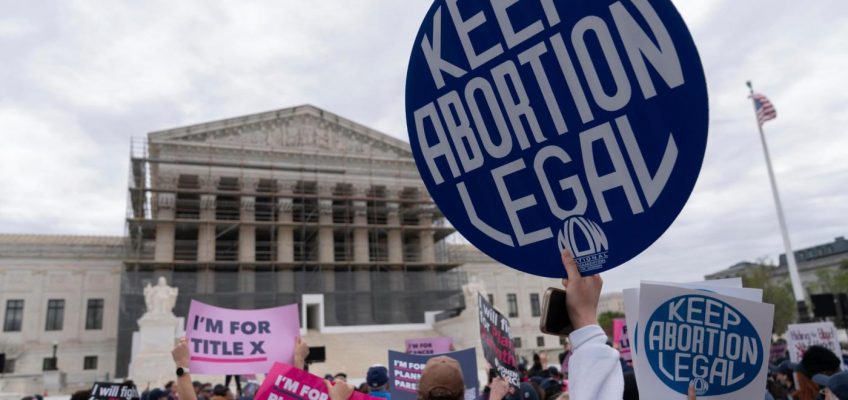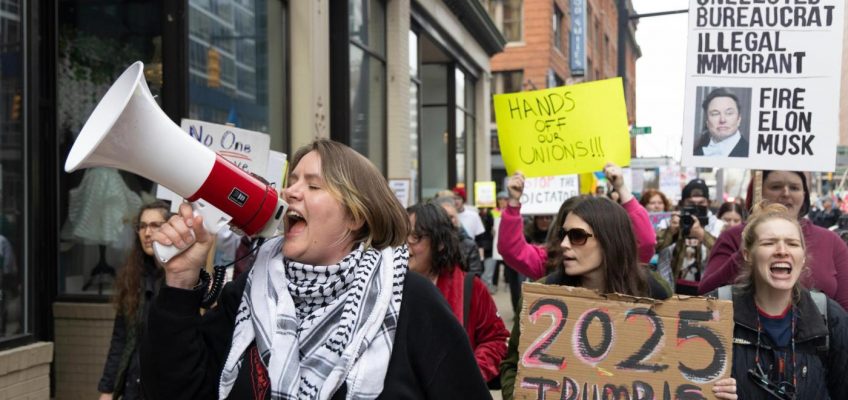By STEVE PEOPLES, Associated Press National Politics Writer
NEW YORK (AP) — As President Donald Trump pushes the historical boundaries of executive power, some of the Democratic Party’s core political institutions are preparing for the possibility that the federal government may soon launch criminal investigations against them.
The Democrats’ dominant national fundraising platform, ActBlue, and the party’s largest protest group, Indivisible, are working with their attorneys for just such a scenario, according to officials within both organizations. Trump’s top political allies have suggested both groups should face prosecution.
Other Democratic allies are planning for Trump-backed legal crackdowns as well. Wary of antagonizing the president, most prefer to stay anonymous for now.
“Every one of our clients is concerned about being arbitrarily targeted by the Trump administration. We are going to great lengths to help clients prepare for or defend themselves,” said Ezra Reese, political law chair at Elias Law Group, which represents Democratic groups and candidates and is chaired by Marc Elias, the lawyer who has himself been a Trump target.
FILE – Attorney Marc Elias stands on the plaza of the Supreme Court in Washington, March 21, 2016. (AP Photo/J. Scott Applewhite, File)
An FBI spokesperson declined to comment when asked about potential investigations into ActBlue and Indivisible. But White House press secretary Karoline Leavitt did not downplay the threat of a potential criminal probe when asked specifically whether Trump wants the FBI, the Treasury Department or any other federal agency to investigate Democratic groups.
“Anyone who has (not) broken the law should not be worried,” Leavitt told The Associated Press. “If you have broken the law and engaged in the weaponization of justice, then you should be worried. It’s that simple.”
Indeed, far from distancing themselves from talk of retribution, many key Republicans are embracing it.
Trump’s allies argue they are justified in seeking vengeance due to the four criminal prosecutions against Trump, one of which led to multiple felony convictions in New York. There’s no evidence former President Joe Biden influenced the Trump prosecutions in any way.
Matt Schlapp, president of the American Conservative Union, said Democrats needed to be taught not to touch a hot stove.
“Someone needs to get burned for all this activity or they’re just gonna do it again,” he said. “And that’s not hypocrisy; that’s justice.”
Trump has made no secret of his plans to use the power of the federal government to target domestic political adversaries.
During a norm-breaking speech at the Department of Justice last month, Trump cast himself as the country’s “chief law enforcement officer,” a title ordinarily reserved for the attorney general.
On Wednesday, Trump signed an executive order instructing the Justice Department to investigate Miles Taylor, a former Department of Homeland Security official who anonymously penned a book highly critical of his first presidency. Trump said that Taylor was likely guilty of treason, a crime that can carry the death penalty.
Musk calls Indivisible ‘criminals’
Indivisible has been perhaps the most important group in the Democratic resistance since Trump returned to the White House. The group’s leadership in Washington holds regular calls with state-based activists and recently released a detailed protest guide, which offers specific guidance to hundreds of local chapters across the country.
This year alone, Indivisible groups have hosted more than 1,000 protests covering every state in the nation. The group was a key organizer in the recent Hands Off! protests that attracted hundreds of thousands of people across the country.
Letters: We need St. Paul councilors with business sense
US moves ahead on tariffs with investigations into computer chips, pharmaceuticals
A Palestinian activist expecting a US citizenship interview is arrested instead by ICE in Vermont
Judge in Vermont considers whether he has jurisdiction of detained Tufts University student’s case
Maureen Dowd: A lot about Trump doesn’t add up
Trump top adviser and billionaire Elon Musk has publicly condemned Indivisible as “criminals.”
The statement was an apparent reference to violent attacks against Tesla dealerships and vehicles, which have spiked in recent weeks. Indivisible’s leadership released a guide earlier in the year encouraging protests outside Tesla dealerships, although the guide instructs protesters to remain peaceful and stay off private property.
No charges are known to have been filed against Indivisible or its leaders. But Indivisible co-founder Ezra Levin says it’s critical that Democratic institutions work together to speak out against the threats posed by the Trump administration. His organization has been discussing contingency plans with attorneys and other activists in the event that he or other Indivisible leaders face criminal charges.
“They may try to come at us directly, or it’s as likely that their non-state actors are inspired by their lies and propaganda, and try to come at us individually,” Levin said. “And that is a risk in a moment where you’re facing anti-democratic threats like we are.”
“Our choice is, we can be quiet and hope that they won’t target us, or we can try to work as a mass opposition,” he continued. “If you’re not willing to do that, what are you doing here?”
Democrats’ fundraising at risk
Musk, backed by several Republican members of Congress, has also called on the FBI to investigate ActBlue, alleging that the Democratic Party’s main fundraising platform has skirted campaign finance laws and allowed foreign nationals to make illegal contributions to Democratic candidates.
“I think the FBI’s going to do something on ActBlue soon,” Charlie Kirk, a key Trump ally who founded the conservative group Turning Point USA, said at a political event last month in Wisconsin.
ActBlue officials this week told the AP that they would continue to cooperate with a congressional investigation led by House Republicans into allegations of fraud within the organization. ActBlue is preparing a second batch of documents to comply with a new request by House Republicans. Additionally, two ActBlue staffers are expected to testify before a House panel behind closed doors later this month.
Multiple House Republicans in recent weeks have encouraged federal law enforcement agencies to pursue requested criminal investigations into ActBlue.
Rep. Darrell Issa, R-Calif., has asked the Treasury Department to investigate allegations that the nonprofit processed payments to “terror-linked organizations.” Separately, Rep. Andy Biggs, R-Ariz., sent a letter to the FBI last month claiming that ActBlue is being used to “to skirt the integrity of federal campaign finance laws” by allowing foreign nationals to contribute to campaigns, among other allegations of criminal wrongdoing.
“It must be emphasized that these allegations, were they to prove true, would indicate a serious threat to the integrity of our elections, besides the victimization of American citizens,” Biggs wrote.
ActBlue said it is preparing for the possibility of “many different attacks on various fronts,” including investigations by the FBI or the Treasury Department.
Meanwhile, Democratic candidates are relying on ActBlue to fund their campaigns as never before.
Donors have given more than $400 million to Democratic candidates through ActBlue over the first three months of the year, the organization told the AP. The fundraising haul represents the most money raised in any first quarter in ActBlue’s two-decade history.
While Republicans accuse the group of being funded by wealthy donors, ActBlue acts as a passthrough between donors and candidates that’s funded by a 3.95% processing fee on each donation.
“These unfounded attacks haven’t shaken us — they’ve sharpened our resolve to fuel Democratic wins,” ActBlue spokesperson Megan Hughes said. “As our first-quarter fundraising demonstrates, Democratic grassroots donors are engaged, undeterred and ready to meet this moment.”
Leavitt is one of three administration officials who face a lawsuit from the AP on First- and Fifth Amendment grounds. The AP says the three are punishing the news agency for editorial decisions they oppose. The White House says the AP is not following an executive order to refer to the Gulf of Mexico as the Gulf of America.




